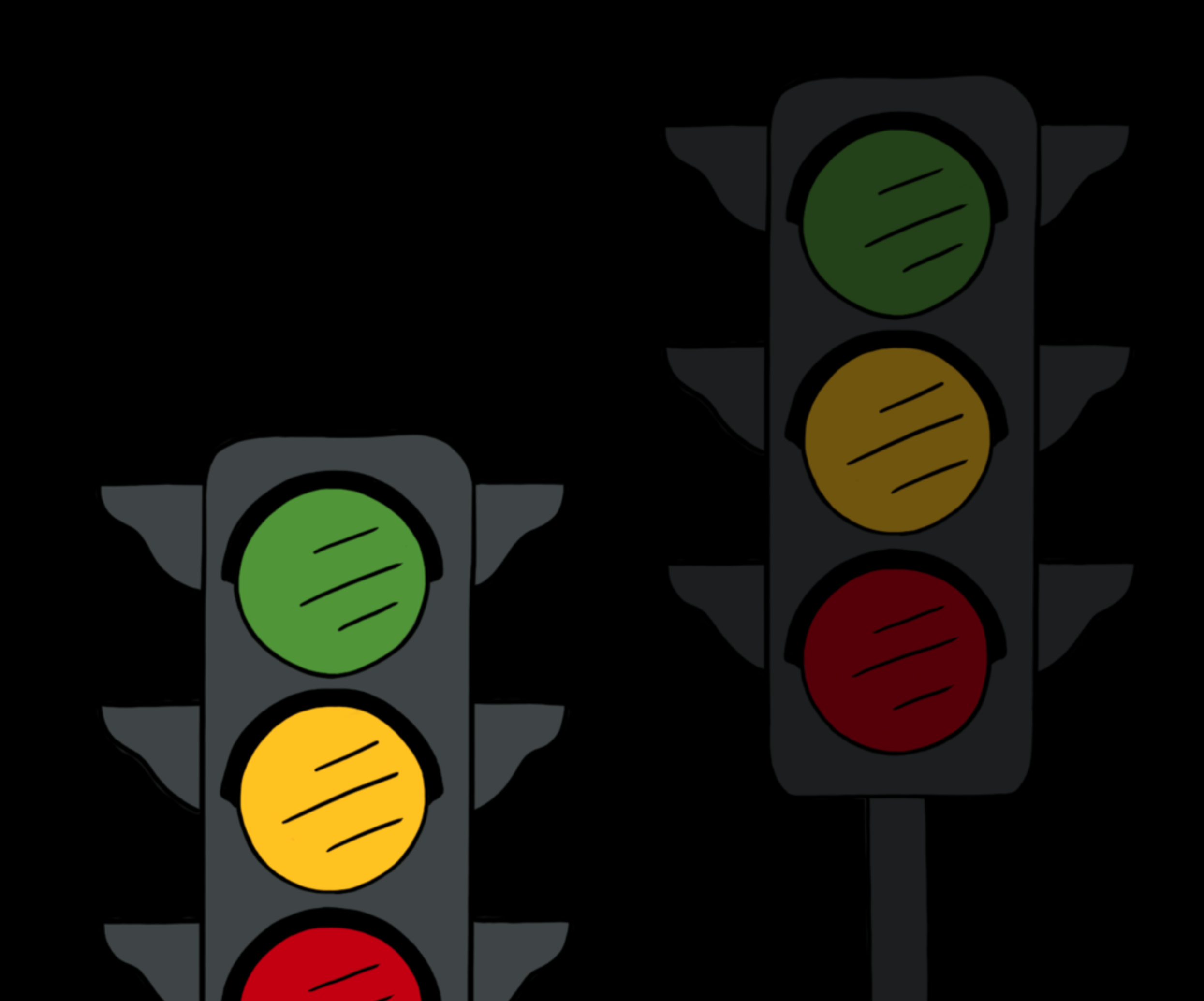
How to use the Cope course
This lesson will talk about how to use the Cope course, and the different zones and exercise categories within it.
If you're someone who likes to just jump right in and see for yourself, that's fine — this is simply here to read or skim if you need some extra guidance, or want to know how it all works.
What are ‘Zones’
So the welcome video for ‘Cope’ already covered this a little but just to recap —
This part of the course is filled with guided exercises and practices that can help you regulate the nervous system and find support when you need it.
The Cope section is made up of four different ‘zones’ that represent our different nervous system states, and each zone is colour coded so that you can quickly identify where you’re at, and find exercises that are specifically tailored to whatever zone you’re in at that moment.
If you haven’t already, you can also read more about these zones and how the nervous system works in the Learn course here.
Exercise Categories
For each zone there is also a variety of different exercise types, so that you can find the ones that work for you.
What’s important to keep in mind when using this program is that not all the exercises will be right for you. What works and is calming or stabilising for one person might not work that well or could possibly even be triggering for another person. This is normal and okay - we are all nuanced human beings and we need to find out what works for us.
I recommend trying out some of the exercises when you’re feeling relatively calm and okay first, both to get a feel for them and also so that you can decide whether you liked or disliked particular ones.
Below are a list of the exercise categories with a brief description so that you can get an idea of which ones might work for you:

Breathing Exercises involve working with the breath to help regulate the nervous system. Learning to consciously work with the breath, even if its just for a couple of minutes a day, can help to bring the nervous system back into that parasympathetic activation of the green zone.
And there are lots of different ways we can do this — some of the exercises in this category involve counting the breath or breathing into the belly, some involve using the breath to discharge energy, and some help find balance by alternating which nostril we breathe into.
For some people, focussing on the breath can sometimes be a bit too overwhelming for them — if you already know that’s the case for you, you can feel free to skip this category altogether. If you’re unsure, you can maybe try watching some of the videos while you’re in the green zone first, to see if any of them feel okay for you.

Grounding Exercises involve orienting the nervous system back to the here and now by engaging the senses — whether we’re using sight, sound, smell, taste, or even things like tactile touch (including pressure and temperature), proprioception (our position in space), and our vestibular sense (our balance and where we are in space).
Exercises in this category range from orienting between our internal and external environment, focusing solely on the external environment through the five senses, grounding through the feet, or finding anchors to the present moment through familiar objects and touchstones.
Grounding exercises can help the nervous system to recalibrate and establish a more accurate perception of safety and danger in the present moment, which can reduce overwhelm and help the nervous system return to that regulated state of the green zone.
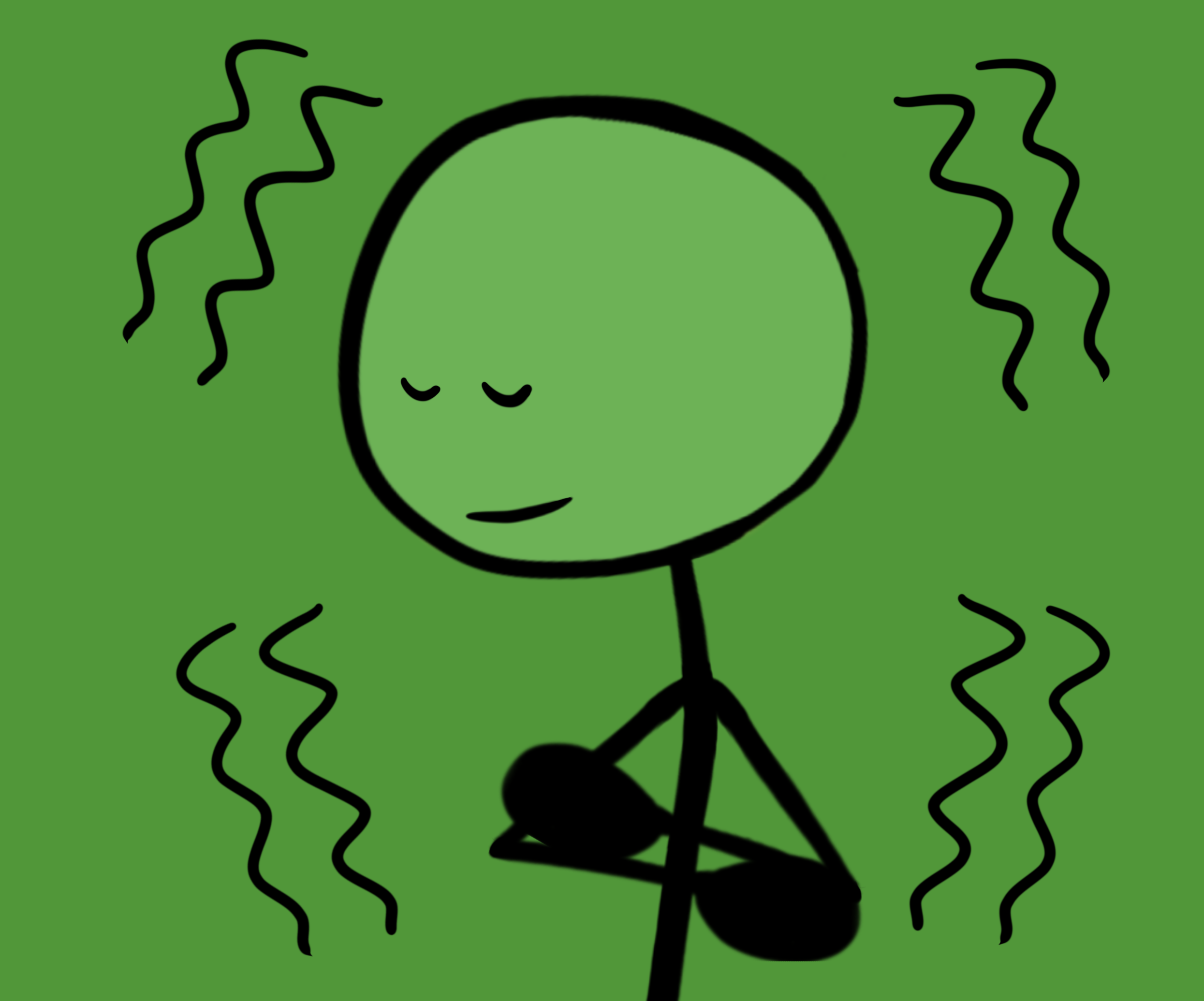
Somatic Exercises involve using very subtle movement in the body to create a sense of safety, connection, containment, or release. At first these exercises can seem really minor or basic, but they can have such a powerful effect because we’re essentially helping the nervous system to tap into its own innate ability to process and settle on its own.
Exercises in this category can range from holding the arms in a somatic hug, holding the hands to your centre, tensing and releasing the muscles, or pressing on particular points that are connected to the vagus nerve
For some people, focussing on the body in this way can sometimes be a bit too overwhelming. These exercises have been written in a particular way for each zone to try and mitigate this, however as always you can skip this category altogether if you think it might be too much for you. And if you’re unsure, you can maybe try watching some of the videos while you’re in the green zone first, to see if any of them feel okay for you.

Movement Exercises involve combining active movements with guidance to help regulate the nervous system, and increase the nervous system’s capacity to tolerance stress.
The exercises in this category range from guided walking practices, guided runs, guided yoga, and other active movements that can help to either discharge energy, or find gentle ways to settle and soothe the nervous system.
Some people can find physical exercise and movement a bit too overwhelming — and if that’s the case for you I wouldn’t discount this whole category altogether just yet. While there are some more active exercises that might be too much right now, there are many gentle practices here to try. The walking exercises are very light and combine grounding with movement, and the exercises in the red and orange zones are also particularly slow and gentle. As always, you can try watching some of the videos while you’re in the green zone first, to see if any of them feel okay for you.
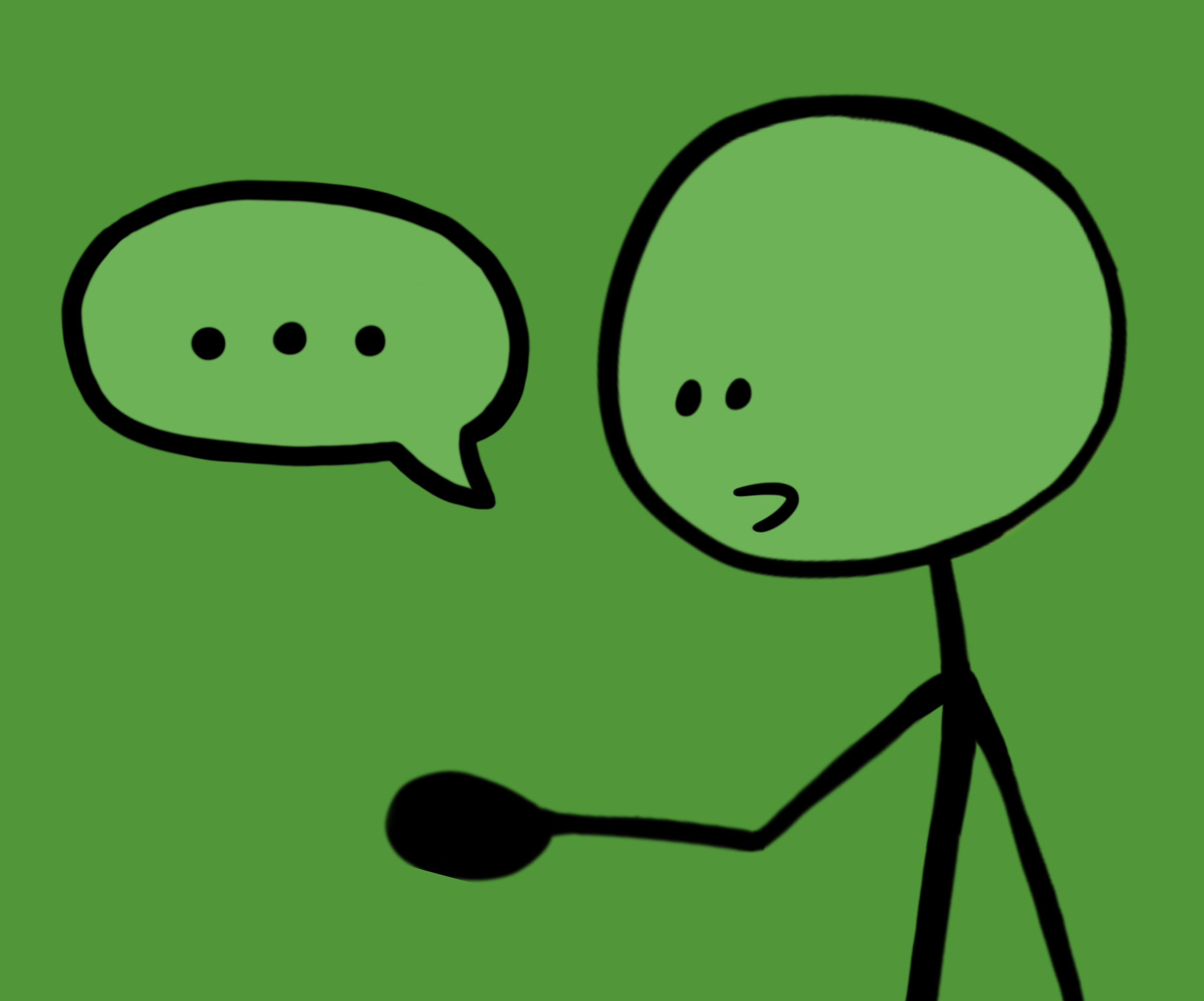
Self-Talk Exercises are all about learning to notice, name and validate our internal experiences. It might sound strange but our brain feels better when we find the right words to fit our experiences. Here we are using language to connect with whatever is going on within us, and find the words we can say to ourselves to help the nervous system settle and relax
Exercises in this category might involve noticing and naming feelings and sensations in the present moment, using particular phrases to provide comfort for ourselves, or doing parts work. Parts work involves identifying parts within us and speaking to these parts with curiosity so that we can understand what’s going on a little better.
For some people, focussing on our internal sensations and feelings can be a bit too overwhelming. If you’re unsure, I recommend easing into the exercises and trying them out slowly, again maybe watching some of the videos while you’re in the green zone first to see if any of them feel okay for you. And remember that you always have choice here and can skip any exercises that don’t feel right for you.
For me there is a lot of magic in this category. My main passion when working with clients as a counsellor, and now also here in Stabilise, is helping people learn to speak to themselves with more kindness. There are countless studies that show that being treated with kindness, connection and compassion helps to regulate the nervous system, improves your overall health, and even reduces the likelihood of illness and heart disease! But more on that later.

How to use each section
Each zone has a quick introduction below that talks about how you can best use the exercises for that section, which I highly recommend reading before you begin:

When you’re in the green zone it might seem like that's when you need to use coping exercises the least, because you’re feeling fine and don’t really need the extra support regulating in that moment.
But this is one of the most useful times to do these exercises, at least starting out, because you’re in a state where you are able to take the time to choose an exercise, try it out, decide if it works for you, and begin forming habits. The more you do an exercise, the more automatic it becomes for you, and the easier it is for you to remember how to regulate during times of stress or overwhelm.
A lot of the exercises written for the green zone are all about habit forming. They introduce the basic versions of exercises that serve as the building blocks for exercises in the other zones.
Some examples of green zone exercises that do this include:
There are also some exercises in this section that are designed to stretch you. In order to improve our resilience to stress and improve our ability to stay regulated, we need to widen our window of tolerance. And a big way of doing that is by gently helping our nervous system to stretch beyond its current level of tolerance, by trying new things, and learning to pendulate between discomfort and comfort. And these are best done when you're feeling safe and okay in the green zone.
Some examples of green zone exercises that do this include:
- Guided run: pendulation
- Orienting: internal and external
There are also some exercises that are about expanding our ability to take in the good. When we’re in the green zone, we’re usually feeling safe, okay, or even really great. But for some of us who have experienced prolonged stress or trauma, sometimes it’s actually really hard for us to take in the good. So when you’re trying out exercises in this zone, you can also use it as an opportunity to take in the good — whether that’s feeling positive sensations during a somatic exercise, finding the beauty in things when you’re orienting around you, or using a self-talk exercise that focuses on taking in the positive.
Some examples of green zone exercises that do this include:
- Gratitude practice
- Speaking with kindness
My recommendation when you’re in the green zone is to use these exercises, and the exercises of the other zones, to explore — explore what you like, what you don’t like, explore your nervous system, your emotions, how you speak to yourself, what regulation feels like for you, and explore how to be kind to yourself.

The yellow zone is when our nervous system is hyper-aroused. Our nervous system has gone into a ‘danger’ response, and we might be feeling anxious, agitated, stressed, tense or overwhelmed.
When we’re in this state we have a lot of active energy, so the exercises in this zone are aimed toward helping that overwhelm settle back down — and we can do this through either resourcing practices, discharging practices, or working with our emotions.
Many of the exercises written for the yellow zone section focus on resourcing the body to find a sense of safety again, which helps the nervous system to turn off that danger response and return back to the green zone. Resourcing is the practice of inviting our mind or body to attune to signs of safety or okayness, however small they may be. And we can do this whether it’s through the mind, the body, or the environment around us.
Some examples of yellow zone exercises that do this include:
- Orienting: external environment
- Somatic hug for containment
There are also some exercises in this section that are designed to help discharge that active energy of the yellow zone. The strong impulses of our fight/flight response can become stuck, which is why we can continue to feel this sense of anxiety or overwhelm in the yellow zone even if there isn’t an immediate danger in front of us. Discharging exercises help us to safely express and release the active energy and arousal of the nervous system, and this might come in the form of movement, muscle release, shaking, breath, sound, or even tears.
Some examples of yellow zone exercises that do this include:
- Guided yoga: discharging practice
- Voo breath
Sometimes what causes a yellow response can be strong emotions that perhaps feel overwhelming or dangerous to the nervous system, so there are also some exercises that aim to help a person identify and navigate these emotions first. Being able to name emotions and sensations can send a signal to our amygdala that decreases our arousal, and helps the nervous system to settle and relax.
Some examples of yellow zone exercises that help do this include:
- NAV: name, accept, validate
- Parts work: notice and listen
Because of the hyper-aroused state of the nervous system in the yellow zone, my recommendation when choosing exercises in the yellow zone is to first ask yourself — do I need to help myself settle and resource right now, do I need to lean into this feeling and release it with a little more strength, or do I need to figure out what on earth I'm even feeling? And go from there.

The red zone is when our nervous system is hypo-aroused. Our nervous system has gone into a ‘shut-down’ response and we might be feeling numb, low energy, disconnected or depressed.
When we’re in this state it can feel hard to move or speak, or to do anything, so the exercises in this zone are designed to really slowly and gently begin to up-regulate the nervous system and start to bring us back online.
The key words here are slowly and gently — our nervous system goes into this immobilisation response to try to protect us, so it’s really important that we work with it at its own pace.
A lot of the exercises written for the red zone are about introducing some sort of connection to the here-and-now, whether that is through small movement, grounding, or breath.
Some examples of red zone exercises that do this include:
- Orienting: connect to the here and now
- Grounding through the feet
There are also some exercises in this section that focus on gently send an up-regulating signal through the vagus nerve that helps bring the brain and nervous system back online.
Some examples of red zone exercises that do this include:
- Ear and jaw massage
- Shh breath
There are also some exercises that focus on resourcing the mind and body to find a sense of safety again, by creating a safe container to gently invite feelings and sensations back to the body.
Some examples of red zone exercises that do this include:
- Somatic hug to create space
- Parts work: notice and listen
My recommendation when choosing exercises in the red zone is to go slowly and be gentle with yourself — these exercises are always simply an invitation, and you have choice, so go at your own pace. It’s hard for anything to feel ‘right’ when you’re shut down, so perhaps ask yourself — what is something I can do that feels the most kind for my nervous system right now? That stretches me by maybe just 1%, or half a percent? And start there.

The orange zone is our panic and freeze response, where we might be experiencing a panic attack.
When we’re in this state we’re feeling both the danger response of the yellow zone whilst also feeling stuck and frozen, and it can feel really scary to experience, so the exercises in the orange zone combine the strategies from both the yellow zone exercises and the red zone exercises — they focus on resourcing to find a sense of safety, or discharging the energy of the panic, all whilst doing it really slowly and gently.
I also introduce a lot of co-regulation in these exercises — where I ask you to check in with me in the videos and remind you that I'm here with you. This is always simply an invitation and you have choice. Having a safe person to co-regulate with you can help the nervous system to settle and relax. Because of how scary a panic attack can be I want to make sure there is that extra layer of support for you in the videos, where I can remind you in that moment that I've got you, and it will pass.
Some examples of orange zone exercises that focus more on resourcing include:
- Orienting: connect back to safety
- 4-4-4 breathing
Some examples of orange zone exercises that focus more on discharging include:
- Press and squeeze
- Cross crawl and sway
My recommendation when you’re choosing exercises in the orange zone is to go slowly, be gentle with yourself, and ask yourself — do I need help settling right now, or do I need help releasing? And go from there, being as kind to yourself as you can.
And remember, if you ever need help, you can always call Lifeline Australia on 13 11 14, or check out the Helplines page for more support options.
Something I want to remind you as you use each section is that the aim of these exercises is not to “get rid” of anything. It’s not to make ourselves suddenly calm and cool by just pushing down or avoiding whatever’s coming up for us, or using breath or movement or whatever to just force our feelings away — the goal is to learn to create space in our nervous system to be able to tolerate our experiences, so that the nervous system can naturally then regulate on its own.
And we do this by leaning in to what we’re feeling — being there for ourselves with kindness and curiosity, and not doing anything without the permission of the parts within us. What I mean by this, is that if you feel this resistance come up — this part that maybe says “no… I don’t want to do this…” we listen to that, and honour it.
Sometimes this might mean ending an exercise early and trying something else, sometimes it might mean that the focus of the practice simply shifts from whatever we started with, to now being there with that feeling of resistance, and making that our new focal point for the exercise. Welcoming it, accepting it, tending to it. This is how we learn to tend to our nervous system. This is what I mean by kindness to self. We’ll touch more on all of this later.
How to choose exercises
I recognise that it can be overwhelming when you start scrolling and you begin to look at the list of options. You might sit there going “how on earth do I choose…”
When starting out, my advice really is just don’t overthink it — simply notice what you’re drawn to. When you were looking at the descriptions just now for each category, which one jumped out at you the most? Start there. Or just flick through the names for each practice and see what grabs you. There’s no right or wrong, we’re just seeing what piques our interest and going from there.
I also want to emphasise that while the exercises are all written specifically for each different zone - there is no right or wrong when choosing exercises for you. If you find that a yellow zone exercise works better for you when you're having a panic attack, of course use it. If a green zone exercise is your favourite when you're feeling shut down or depressed in the red zone, that's great. The structure and colours are simply there for ease of use, but at the end of the day it's about finding what feels right for you.
And by trying things out when you're feeling okay in the green zone first, you can become familiar with how it all works, which will make it that much easier to choose an exercise during times where you're maybe struggling or feeling dysregulated.

Setting up a shortcut for favourites
Once you’ve had a chance to try some exercises out from different zones and categories and you’ve maybe found some ones that work for you, you can then choose to ‘favourite’ these exercises, which can give you a couple go-to ones that you know work for you.
To favourite an exercise, press the heart in the top right corner.
You can then reach these quickly on the Favourites page located in the menu bar, or at the bottom of the cope section, so that your favourite exercises are colour-coded and ready to access when you need them.
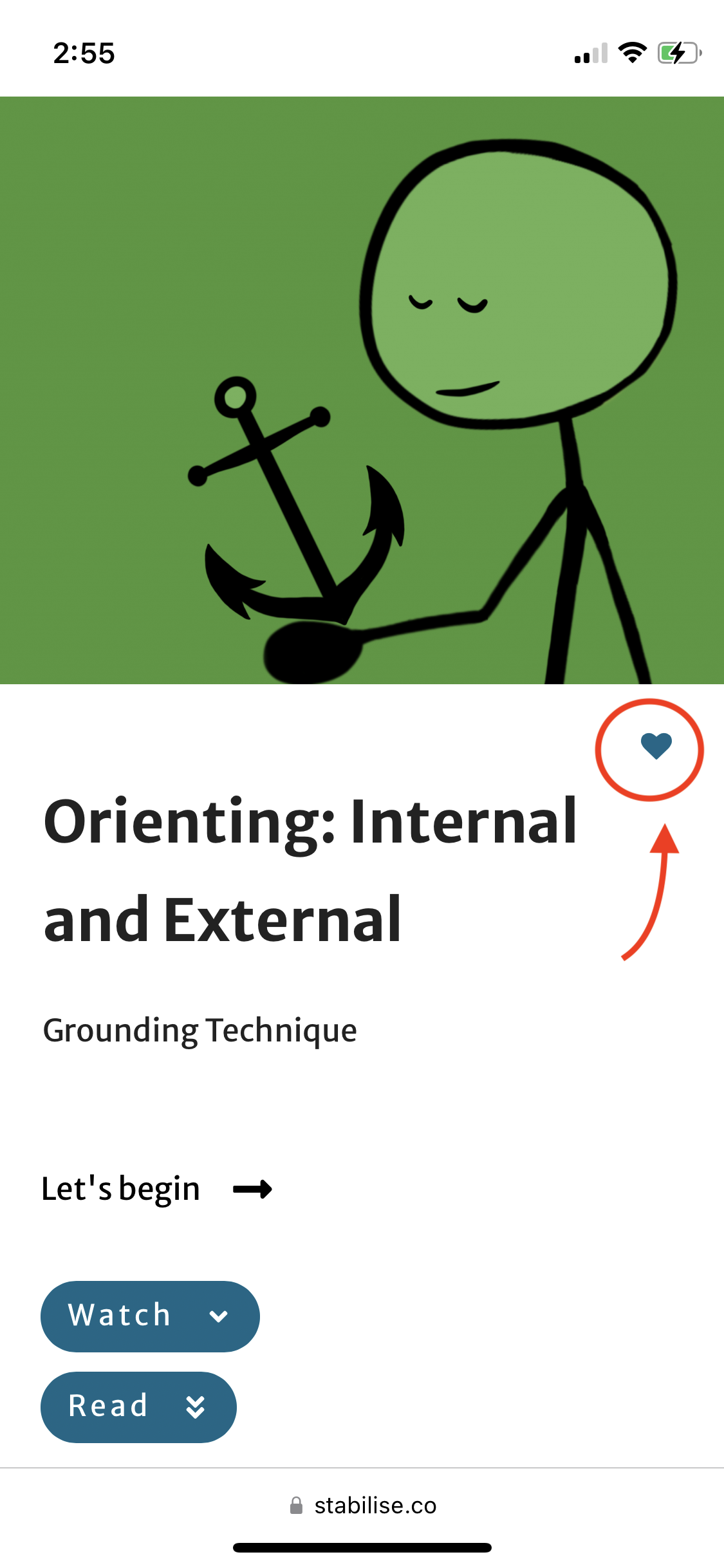
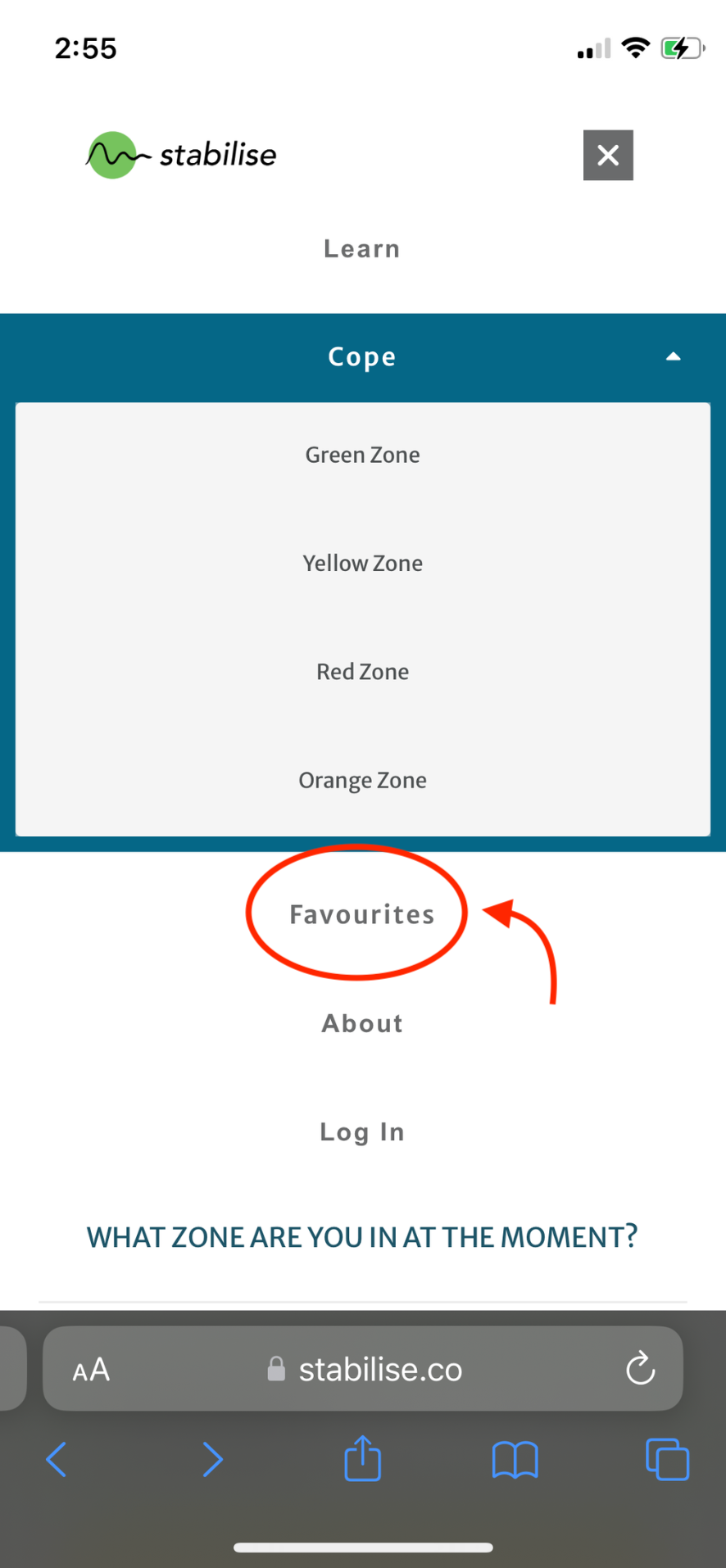

You can even create a shortcut link to this page on your iPhone’s home screen, to give you quick access to your favourite exercises when you need them, so that you can take the thinking and the decision making out of the equation.
To do this, when you're on the Favourites page, press the 'share' icon on your web browser, select "add to Home Screen", change the name to Stabilise (or whatever you'd like to name it), press add, and it'll appear like an app on your Home Screen.
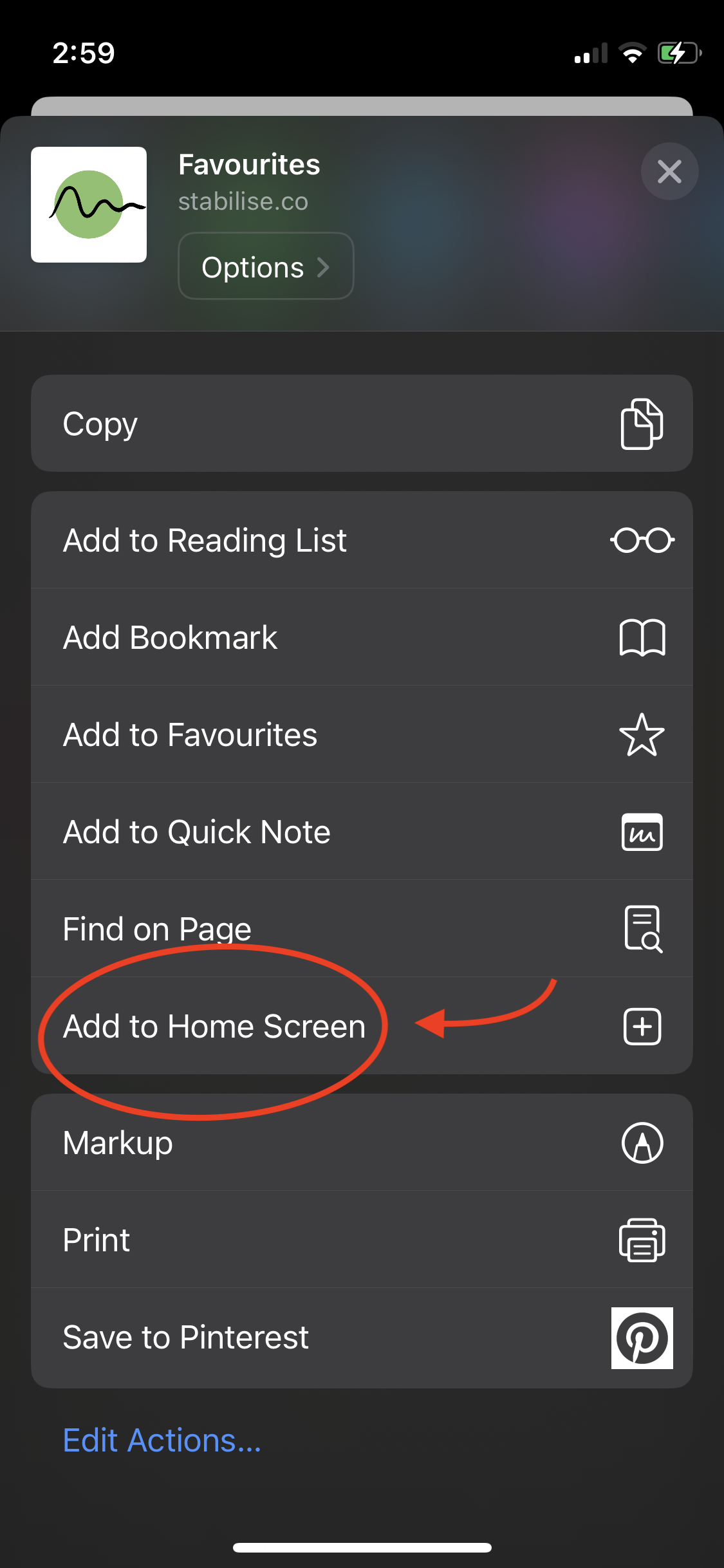

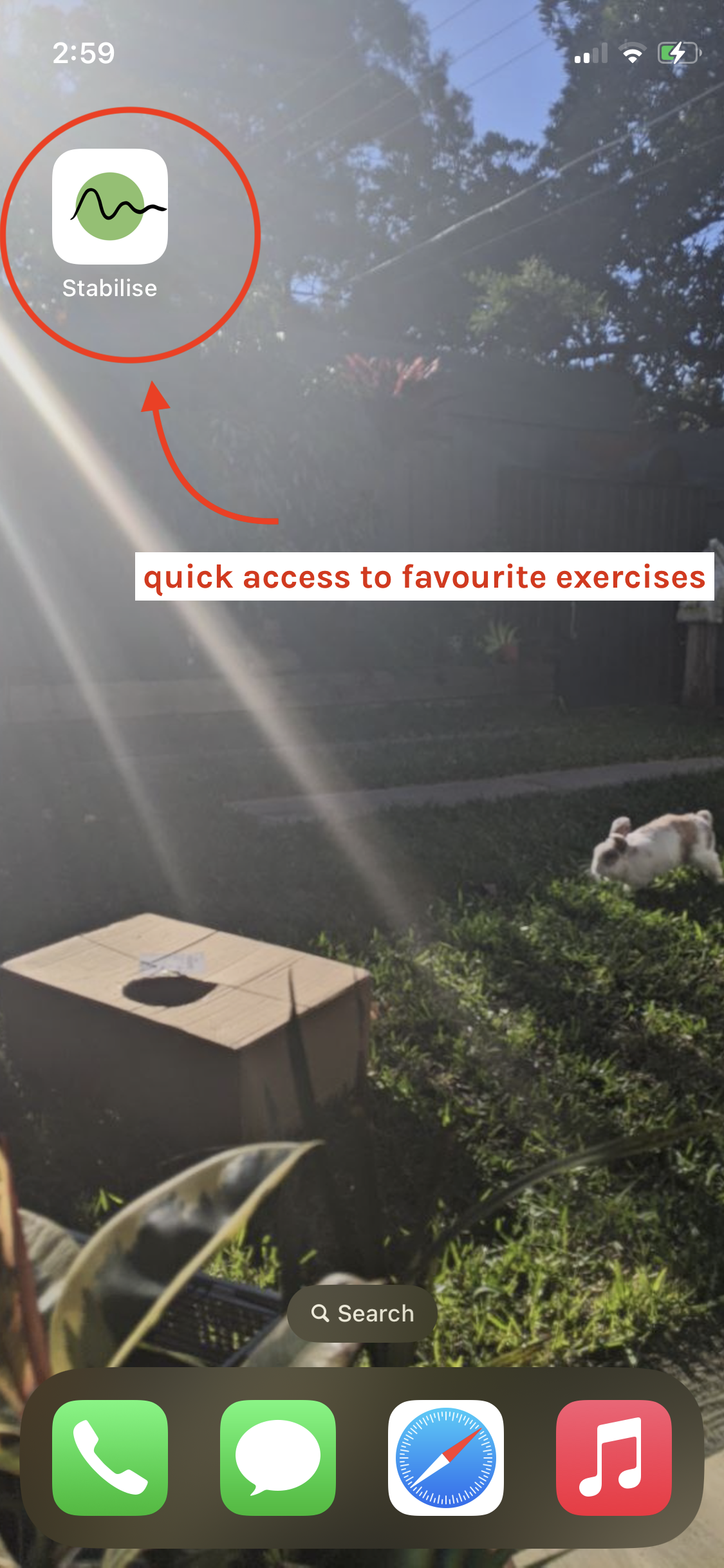

Go gently
As you make your way through this section, remember to be gentle with yourself. Close the app or the video if you want to, take long breaks, and feel free to skip any exercises that don’t resonate.
I want to remind you — it is not necessary to do every exercise that is on offer here.
It’s simply about trying some things out, learning how to work with your nervous system, and then maybe sticking with the ones that work for you.
Nor is it necessary to do them every day.
While it is of course beneficial to repeat exercises so that nervous system regulation becomes a habit, if that's just going to add additional stress or make you want to avoid the responsibility altogether, please take that pressure off yourself. You can do them as often or as little as you like — they will always be there for you in those moments you need them.
I want this to be a place where you have choice and can find what feels right for you — I hope these exercises can help in whatever way they can. And I'll see you there when you're ready.
What's next
The rest of this introduction section is gonna go a bit further and talk about how we can improve our mental health separate from just using the exercises on offer here.
We’ll talk about working with therapists, sleep, nutrition, exercise, medication, other forms of healthcare, and my favourite topic — kindness. This is all optional of course, but the resources are there if you want them.
